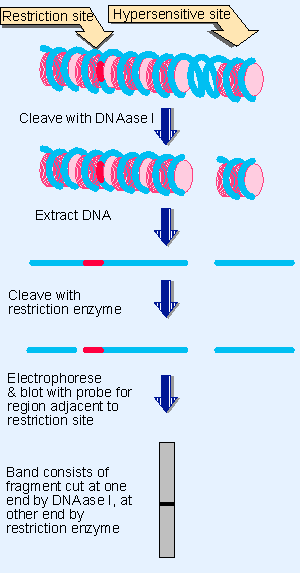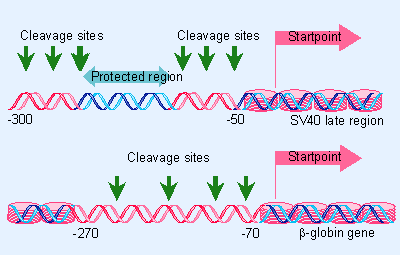11. DNAase hypersensitive sites change chromatin structure
19.11 DNAase hypersensitive sites change chromatin structure |
Chromatin consists of DNA wound around a series of nucleosomes, more loosely packaged in regions that contain active genes. In addition to the general changes that occur in active or potentially active regions, structural changes occur at specific sites associated with initiation of transcription or with certain structural features in DNA. These changes were first detected by the effects of digestion with very low concentrations of the enzyme DNAase I.
When chromatin is digested with DNAase I, the first effect is the introduction of breaks in the duplex at specific, hypersensitive sites. Since susceptibility to DNAase I reflects the availability of DNA in chromatin, we take these sites to represent chromatin regions in which the DNA is particularly exposed because it is not organized in the usual nucleosomal structure. A typical hypersensitive site is 100 more sensitive to enzyme attack than bulk chromatin. These sites are also hypersensitive to other nucleases and to chemical agents (for review see Gross and Garrard, 1988).
 |
Figure 19.39 Indirect end-labeling identifies the distance of a DNAase hypersensitive site from a restriction cleavage site. The existence of a particular cutting site for DNAase I generates a discrete fragment, whose size indicates the distance of the DNAase I hypersensitive site from the restriction site. |
Hypersensitive sites are created by the (tissue-specific) structure of chromatin. Their locations can be determined by the technique of indirect end labeling that we introduced earlier in the context of nucleosome positioning. This application of the technique is recapitulated in Figure 19.39. In this case, cleavage at the hypersensitive site by DNAase I is used to generate one end of the fragment, and its distance is measured from the other end that is generated by cleavage with a restriction enzyme.
A particularly well-characterized nuclease-sensitive region lies on the SV40 minichromosome. A short segment near the origin of replication, just upstream of the promoter for the late transcription unit, is cleaved preferentially by DNAase I, micrococcal nuclease, and other nucleases (including restriction enzymes) (Varshavsky et al., 1978; Scott and Wigmore, 1978).
 |
Figure 19.40 The SV40 minichromosome has a nucleosome gap. Photograph kindly provided by Moshe Yaniv. |
The state of the SV40 minichromosome can be visualized by electron microscopy. In up to 20% of the samples, a "gap" is visible in the nucleosomal organization, as evident in Figure 19.40. The gap is a region of ~120 nm in length (about 350 bp), surrounded on either side by nucleosomes. The visible gap corresponds with the nuclease-sensitive region. This shows directly that increased sensitivity to nucleases is associated with the exclusion of nucleosomes.
 |
Figure 19.41 The SV40 gap includes hypersensitive sites, sensitive regions, and a protected region of DNA. The hypersensitive site of a chicken b-globin gene comprises a region that is susceptible to several nucleases. |
A hypersensitive site is not necessarily uniformly sensitive to nucleases. Figure 19.41 shows the maps of two hypersensitive sites.
Within the SV40 gap of ~300 bp, there are two hypersensitive DNAase I sites and a "protected" region. The protected region presumably reflects the association of (nonhistone) protein(s) with the DNA. The gap is associated with the DNA sequence elements that are necessary for promoter function.
The hypersensitive site at the β-globin promoter is preferentially digested by several enzymes, including DNAase I, DNAase II, and micrococcal nuclease. The enzymes have preferred cleavage sites that lie at slightly different points in the same general region. So a region extending from about V70 to V270 is preferentially accessible to nucleases when the gene is transcribable. What is the structure of the hypersensitive site? Its preferential accessibility to nucleases indicates that it is not protected by histone octamers, but this does not necessarily imply that it is free of protein. A region of free DNA might be vulnerable to damage; and in any case, how would it be able to exclude nucleosomes? We assume that the hypersensitive site results from the binding of specific regulatory proteins that exclude nucleosomes. Indeed, the binding of such proteins is probably the basis for the existence of the protected region within the hypersensitive site.
Hypersensitive sites associated with transcription may be generated by transcription factors. When a plasmid containing the hypersensitive region of the adult chick β-globin gene is recombined with histones in the presence of an extract from red blood cell nuclei, the relevant region becomes hypersensitive. The extract cannot confer hypersensitivity if it is added after the histones, which suggests that it must recognize DNA directly and in some way change the organization of the region prior to or during the deposition of nucleosomes. In 21 Regulation of transcription, we discuss similar events at other loci, where transcription factors may have the ability to prevent histones from associating with DNA or (in some cases) to displace them.
The proteins that generate hypersensitive sites are likely to be regulatory factors of various types, since hypersensitive sites are found associated with promoters, other elements that regulate transcription, origins of replication, centromeres, and sites with other structural significance. In some cases, they are associated with more extensive organization of chromatin structure. A hypersensitive site may provide a boundary for a series of positioned nucleosomes.
The stability of hypersensitive sites is revealed by the properties of chick fibroblasts transformed with temperature-sensitive tumor viruses. These experiments take advantage of an unusual property: although fibroblasts do not belong to the erythroid lineage, transformation of the cells at the normal temperature leads to activation of the globin genes. The activated genes have hypersensitive sites. If transformation is performed at the higher (nonpermissive) temperature, the globin genes are not activated; and hypersensitive sites do not appear. When the globin genes have been activated by transformation at low temperature, they can be inactivated by raising the temperature. But the hypersensitive sites are retained through at least the next 20 cell doublings (Groudine and Weintraub, 1982).
This result demonstrates that acquisition of a hypersensitive site is only one of the features necessary to initiate transcription; and it implies that the events involved in establishing a hypersensitive site are distinct from those concerned with perpetuating it. Once the site has been established, it is perpetuated through replication in the absence of the circumstances needed for induction. Could some specific intervention be needed to abolish a hypersensitive site?
| Reviews | |
| Gross, D. S. and Garrard, W. T. (1988). Nuclease hypersensitive sites in chromatin. Ann. Rev. Biochem 57, 159-197. | |
| Research | |
| Groudine, M. and Weintraub H. (1982). Propagation of globin DNAase I-hypersensitive sites in absence of factors required for induction: a possible mechanism for determination. Cell 30, 131-139. | |
| Scott, W. A. and Wigmore, D. J. (1978). Sites in SV40 chromatin which are preferentially cleaved by endonucleases. Cell 15, 1511-1518. | |
| Varshavsky, A. J., Sundin, O., and Bohn, M. J. (1978). SV40 viral minichromosome: preferential exposure of the origin of replication as probed by restriction endonucleases. Nucleic Acids Res. 5, 3469-3479. | |